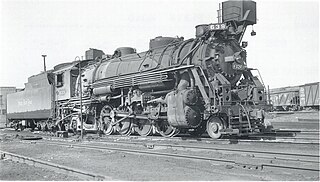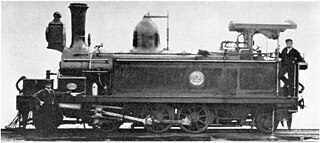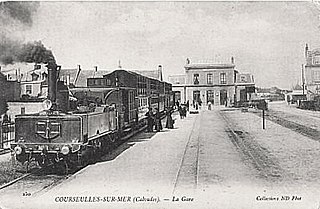
A Fairlie locomotive is a type of articulated steam locomotive that has the driving wheels on bogies. The locomotive may be double-ended or single ended. Fairlies are most famously associated with the Ffestiniog Railway in North Wales.

The Davenport Locomotive Works, of Davenport, Iowa, USA was formed as the W W Whitehead Company in 1901. In 1902 the company commenced building light locomotives. The Company was renamed the Davenport Locomotive Works in 1904.

4-4-0 is a locomotive type with a classification that uses the Whyte notation for the classification of steam locomotives by wheel arrangement and represents the arrangement: four leading wheels on two axles, four powered and coupled driving wheels on two axles, and a lack of trailing wheels. Due to the large number of the type that were produced and used in the United States, the 4-4-0 is most commonly known as the "American" or "Eight-Wheeler" type, but the type subsequently also became popular in the United Kingdom, where large numbers were produced.

Under the Whyte notation for the classification of steam locomotives, 2-8-2 represents the wheel arrangement of two leading wheels on one axle, usually in a leading truck, eight powered and coupled driving wheels on four axles and two trailing wheels on one axle, usually in a trailing truck. This configuration of steam locomotive is most often referred to as a Mikado, frequently shortened to Mike.
The War Department Light Railways were a system of narrow gauge trench railways run by the British War Department in World War I. Light railways made an important contribution to the Allied war effort in the First World War, and were used for the supply of ammunition and stores, the transport of troops and the evacuation of the wounded.

Under the Whyte notation for the classification of steam locomotives, 2-6-2 represents the wheel arrangement of two leading wheels, six coupled driving wheels and two trailing wheels. This arrangement is commonly called a Prairie.
Under the Whyte notation for the classification of steam locomotives by wheel arrangement, a 2-6-6-2 is a locomotive with one pair of unpowered leading wheels, followed by two sets of three pairs of powered driving wheels and one pair of trailing wheels. The wheel arrangement was principally used on Mallet-type articulated locomotives, although some tank locomotive examples were also built. A Garratt locomotive or Golwé locomotive with the same wheel arrangement is designated 2-6-0+0-6-2 since both engine units are pivoting.

Under the Whyte notation for the classification of steam locomotives, 0-4-2 represents the wheel arrangement with no leading wheels, four powered and coupled driving wheels on two axles and two trailing wheels on one axle. While the first locomotives of this wheel arrangement were tender engines, the configuration was later often used for tank engines, which is noted by adding letter suffixes to the configuration, such as 0-4-2T for a conventional side-tank locomotive, 0-4-2ST for a saddle-tank locomotive, 0-4-2WT for a well-tank locomotive and 0-4-2RT for a rack-equipped tank locomotive.
Indian Railways operates India's railway system and comes under the purview of the Ministry of Railways of Government of India. As of 2023, it maintains over 108,706 km (67,547 mi) of tracks and operates over 13,000 trains daily with a fleet of 14,800 locomotives. The railways primarily operates a fleet of electric and diesel locomotives along with a few compressed natural gas (CNG) locomotives. Steam locomotives are operated on mountain railways and on heritage trains.

The Chemins de Fer du Calvados was a 600 mm narrow gauge railway in the département of Calvados.

Decauville was a manufacturing company which was founded by Paul Decauville (1846–1922), a French pioneer in industrial railways. Decauville's major innovation was the use of ready-made sections of light, narrow gauge track fastened to steel sleepers; this track was portable and could be disassembled and transported very easily.

The Sierra Leone Government Railway operated in Sierra Leone from 1897 to 1974. It was unusual in that it formed a national railway system constructed solely to a 2 ft 6 in narrow gauge, whereas in other countries, gauge of such a narrow width was usually confined to feeder railways.

The Baldwin Class 10-12-D was a class of narrow gauge 4-6-0PT steam locomotives built by the Baldwin Locomotive Works (USA) for the British War Department Light Railways for service in France during World War I. They were built in 1916–1917 to 600 mm gauge.

The Froissy Dompierre Light Railway is a 600 mm narrow gauge light railway running from Froissy to Dompierre-Becquincourt, through Cappy, in the Somme department, France. It is run as a heritage railway by APPEVA and is also known as P'tit Train de la Haute Somme. It is the last survivor of the 600 mm narrow gauge trench railways of the World War I battlefields.
The Otavi Mining and Railway Company was a railway and mining company in German South West Africa. It was founded on 6 April 1900 in Berlin with the Disconto-Gesellschaft and the South West Africa Company as major shareholders.

The Tramway de Pithiviers à Toury (TPT) was a 600 mm gauge railway in the Loiret department of France. It was built to carry sugar beet and was 80 kilometres (50 mi) long.

The South African Railways Class NG1 0-4-0T of 1900 was a narrow-gauge steam locomotive from the pre-Union era in Transvaal.

French Morocco had from 1912 to 1935 one of the largest 600 mm gauge network in Africa with a total length of more than 1,700 kilometres (1,100 mi). After the treaty of Algeciras where the representatives of Great Powers agreed not to build any 1,435 mm standard-gauge railway in Morocco until the standard-gauge Tangier–Fes railway being completed, the French begun to build military 600 mm gauge lines in their part of Morocco French Morocco.

The Chemin de fer du Val de Passey is a 0.8 km (0.5 mi) long heritage railway with 600 mm gauge near Choloy-Ménillot southwest of Toul in France.

The Donon Light Railway was a 44.3 km (27.5 mi) long narrow-gauge 700 mm gauge forest railway in the Donon mountains. It ran from Schirmeck in the Alsatian-speaking Alsace to Allarmont, Colas and Moussey in the French-speaking Vosges.




































